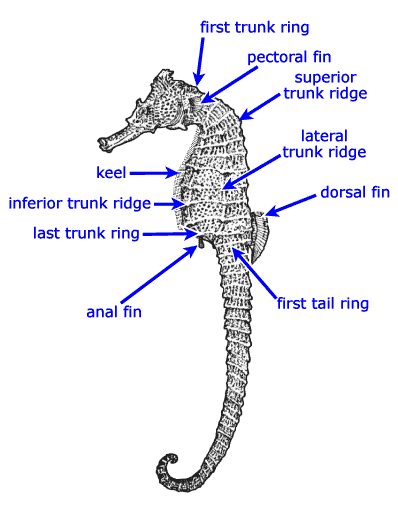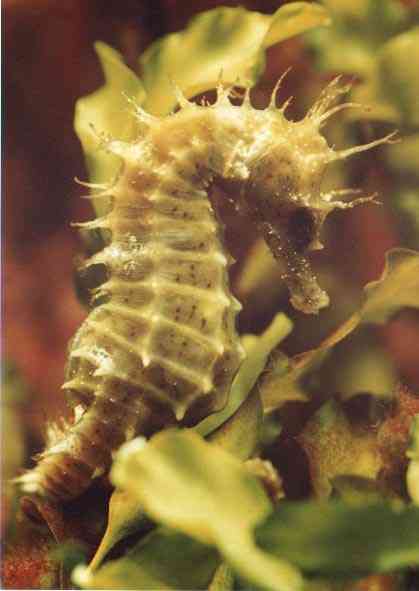
Seahorse Facts
Currently, throughout the world, there are 35 known species of seahorses. Seahorses belong to the order Syngnathiforme, family Syngnqnathidea and genus Hippocampus and are classified in the same family as Pipefish, and Seadragons (31). As their name implies, seahorses are best known for their horse shaped head, followed by their distinctive trunk and tail. A seahorses's body is spiky and rough because of concentric bony rings that structure their entire body (20) (figure 2). You can determine a certain seahorse species by counting the number of rings from the first trunk ring to the last trunk ring on its body (figure 1).
Unlike most fish, seahorses swim upright and propel themselves by a dorsal fin which beats close to 35 times per second (6). The small size of the dorsal fin along with small ear-like pectoral fins make seahorses more adept to maneuvering than speed (7). Because of their immobility, seahorses rarely migrate, instead choosing to anchor themselves close to home.
Figure 1

picture provided by projectseahorse.org
A seahorse's lack of mobility is compensated for by fascinating defense mechanisms. One such mechanism is the ability to camouflage itself by rapidly changing colors in order to blend into their surroundings and evade predation (6). Another defense mechanism used is mimicry in which some seahorses have adapted appendages that allow them to hide among algae and corals (figure 2). Although voracious, seahorses choose to be opportunistic instead of dynamic predators. Seahorses have no teeth and so they stalk their prey, waiting for them to get close enough before sucking them in through their tubular snout. Smaller seahorses like Hippocampus Zostrae feed mostly on copepods while the larger H. abdomalis feed on larger amphipods, caridean shrimp, and peracarids (28). The preferred habitat for seahorses is shallow sea-grass beds, coral reefs, and mangrove roots where they spend most of the day hidden and out of sight. Seahorses live in warm, salt waters 45 degrees North and South of the equator (31).
Figure 2
 Male
and female seahorses are strikingly similar in appearance. The only visible,
morphological difference is that the males have a brood stomach pouch, adapted
for purposes of reproduction. Seahorses are unique in that they are one of the
few organisms in which the male carries and gives birth to the offspring.(27).
When seahorses breed, the female uses her ovipositor, which is located close
to the anal fin, to deposit her eggs in the male's brood pouch which is either
located on the male's abdomen or tail (27). The
brood pouch provides nutrients and oxygen to the fry, and also removes all harmful
waste. It also functions as an osmotic adaptation chamber, which changes the
composition of the internal fluids during pregnancy to match the surrounding
seawater. This improves survivorship by reducing the stress on offspring after
birth (27). Depending on the species, fry hatch
anywhere from ten to forty-two days later, and males can give birth to anywhere
between 10 to 200 young. Seahorses vary in size from the 1 inch Dwarf Seahorse,
to almost a foot long, characteristic of the Pot Bellied Seahorse.
Male
and female seahorses are strikingly similar in appearance. The only visible,
morphological difference is that the males have a brood stomach pouch, adapted
for purposes of reproduction. Seahorses are unique in that they are one of the
few organisms in which the male carries and gives birth to the offspring.(27).
When seahorses breed, the female uses her ovipositor, which is located close
to the anal fin, to deposit her eggs in the male's brood pouch which is either
located on the male's abdomen or tail (27). The
brood pouch provides nutrients and oxygen to the fry, and also removes all harmful
waste. It also functions as an osmotic adaptation chamber, which changes the
composition of the internal fluids during pregnancy to match the surrounding
seawater. This improves survivorship by reducing the stress on offspring after
birth (27). Depending on the species, fry hatch
anywhere from ten to forty-two days later, and males can give birth to anywhere
between 10 to 200 young. Seahorses vary in size from the 1 inch Dwarf Seahorse,
to almost a foot long, characteristic of the Pot Bellied Seahorse.
Seahorses are susceptible to over-fishing and extinction due to their biology and behavior. The small brood size, along with the great amount of effort and time the father puts into his young, allows there to be a great potential for him to get caught, along with the growing young in his brood pouch (31). It is apparent that the current amount of young able to reach sexual maturity cannot supplant the extraction of seahorses, leading to diminishing populations (19). Most seahorse species are monogamous, and so if they lose their life-partner, there is no chance to reproduce, reducing their potential for high reproduction rates (14). On top of fishing, seahorse habitat is being destroyed at an increasing rate, and since seahorses are not highly mobile, they do not migrate and thus have no means of emmigrating to new areas.
Back to Top
On to Seahorse Depletion